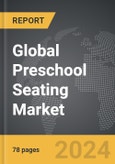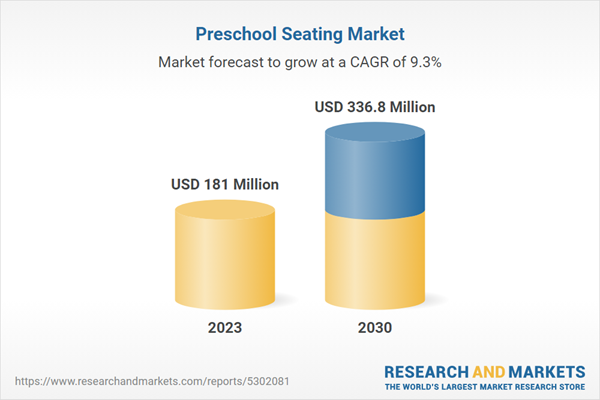The global market for Preschool Seating was estimated at US$181.0 Million in 2023 and is projected to reach US$336.8 Million by 2030, growing at a CAGR of 9.3% from 2023 to 2030. This comprehensive report provides an in-depth analysis of market trends, drivers, and forecasts, helping you make informed business decisions.
Global Preschool Seating Market - Key Trends and Drivers Summarized
Why Is Preschool Seating So Important for Early Childhood Development?
Preschool seating plays a crucial role in shaping the learning environment for young children, influencing both their comfort and ability to engage in classroom activities. Proper seating arrangements are essential for fostering cognitive, physical, and social development in early childhood. Well-designed preschool furniture takes into account the size, posture, and movement needs of young learners, helping them maintain proper posture and reducing physical strain during long periods of sitting. Seating that is appropriately scaled to a child’s size ensures that they can focus on learning without discomfort, while also allowing them the freedom to move and explore their surroundings safely. Additionally, seating that promotes group interaction and collaboration, such as tables with multiple chairs or circular seating arrangements, encourages socialization, communication, and teamwork among preschoolers, key aspects of early social development. Thus, the design and selection of preschool seating not only support the physical needs of young children but also enhance their overall learning experience by creating a comfortable and engaging environment.How Have Innovations in Preschool Seating Addressed Classroom Challenges?
In recent years, innovations in preschool seating have emerged in response to the growing understanding of how classroom environments affect learning outcomes. The shift toward more flexible, adaptable classroom spaces has led to the development of modular seating options that can be easily rearranged to suit different teaching styles and activities. For instance, lightweight and stackable chairs allow teachers to quickly reconfigure the classroom for group work, individual tasks, or open play areas, providing more dynamic learning experiences. Ergonomically designed chairs and seating solutions are now crafted to support children’s natural movements, promoting healthy posture and physical development. These designs often include curved backs and contoured seats to encourage proper alignment of the spine, which is important as preschoolers are still developing their motor skills and coordination. Beyond physical comfort, many seating innovations are focused on creating sensory-friendly environments that accommodate the diverse needs of young learners, including children with sensory processing disorders or special needs. Products like wobble stools or flexible seating cushions allow children to move and shift their weight, which can help improve focus and reduce anxiety or restlessness. Additionally, the use of vibrant colors and playful designs in seating furniture stimulates creativity and makes the classroom more inviting, contributing to an atmosphere where children are eager to learn and participate.Why Is Preschool Seating an Investment in Safety and Durability?
Preschool seating is not just about comfort and engagement but also about safety and durability, which are critical factors in environments with young children. Because preschoolers are highly active and prone to moving around constantly, seating must be designed with safety features that minimize the risk of injury. For example, chairs with rounded edges, non-slip feet, and lightweight but sturdy materials ensure that children can move freely without the risk of tipping over or getting hurt. Manufacturers are increasingly focusing on using non-toxic, child-safe materials such as BPA-free plastics or sustainably sourced wood, which ensures that seating is both safe for children and environmentally friendly. Durability is another key consideration, as preschool furniture must withstand the wear and tear of daily use in busy classrooms. Furniture that is prone to breaking or showing signs of wear quickly becomes a safety hazard and an unnecessary expense for educational institutions. High-quality preschool seating is built to last, using materials that are both sturdy and easy to clean, which is important in a setting where spills and accidents are common. Chairs and tables made from reinforced plastics, metal frames, or heavy-duty wood can endure frequent use without deteriorating. Moreover, many seating options are designed to be stackable or foldable, offering easy storage and allowing educators to maximize space when not in use.What Are the Key Growth Drivers in the Preschool Seating Market?
The growth in the preschool seating market is driven by several factors related to changing educational philosophies, evolving classroom needs, and increasing investment in early childhood education. One of the primary drivers is the rising global focus on early childhood education as the foundation for lifelong learning. Governments, private institutions, and non-profit organizations are increasingly recognizing the importance of investing in high-quality preschool environments, leading to increased spending on child-friendly and developmentally appropriate furniture. As a result, there is a growing demand for seating that supports both the physical and cognitive development of preschoolers, which has spurred innovation and variety in the types of seating available. Another significant driver is the shift toward flexible and inclusive classroom designs. With an increasing emphasis on differentiated learning and accommodating children with diverse needs, schools are seeking seating options that offer flexibility and adaptability. The demand for ergonomic, multi-functional, and sensory-friendly seating solutions has grown as educators strive to create environments that cater to different learning styles and physical abilities. Products like flexible seating arrangements, floor seating options, and sensory-supportive chairs are gaining popularity for their ability to create more dynamic and inclusive learning spaces. Additionally, the rise in awareness around child safety and sustainability is influencing the market, as more educational institutions prioritize furniture made from eco-friendly and non-toxic materials. Parents and educators alike are becoming more conscious of the environmental impact of the products used in schools, driving demand for seating that is safe for children and produced using sustainable manufacturing processes. Lastly, the increasing adoption of digital learning and blended educational models is pushing schools to rethink traditional seating arrangements. With more emphasis on collaboration, creative activities, and movement within the classroom, the need for versatile, easy-to-rearrange seating has grown, further driving market demand. Collectively, these factors contribute to the expanding preschool seating market, ensuring that manufacturers continue to innovate in response to evolving educational needs and standards.Regional Analysis
Gain insights into the U.S. market, estimated at $47.5 Million in 2023, and China, forecasted to grow at an impressive 13.2% CAGR to reach $84.0 Million by 2030. Discover growth trends in other key regions, including Japan, Canada, Germany, and the Asia-Pacific.Why You Should Buy This Report:
- Detailed Market Analysis: Access a thorough analysis of the Global Preschool Seating Market, covering all major geographic regions and market segments.
- Competitive Insights: Get an overview of the competitive landscape, including the market presence of major players across different geographies.
- Future Trends and Drivers: Understand the key trends and drivers shaping the future of the Global Preschool Seating Market.
- Actionable Insights: Benefit from actionable insights that can help you identify new revenue opportunities and make strategic business decisions.
Key Questions Answered:
- How is the Global Preschool Seating Market expected to evolve by 2030?
- What are the main drivers and restraints affecting the market?
- Which market segments will grow the most over the forecast period?
- How will market shares for different regions and segments change by 2030?
- Who are the leading players in the market, and what are their prospects?
Report Features:
- Comprehensive Market Data: Independent analysis of annual sales and market forecasts in US$ Million from 2023 to 2030.
- In-Depth Regional Analysis: Detailed insights into key markets, including the U.S., China, Japan, Canada, Europe, Asia-Pacific, Latin America, Middle East, and Africa.
- Company Profiles: Coverage of major players in the Global Preschool Seating Market such as Gonzagarredi Montessori, Guangzhou Everpretty Furniture Co., Ltd., Intermetal SA, Jonti-Craft, KI and more.
- Complimentary Updates: Receive free report updates for one year to keep you informed of the latest market developments.
Some of the 11 companies featured in this Global Preschool Seating market report include:
- Gonzagarredi Montessori
- Guangzhou Everpretty Furniture Co., Ltd.
- Intermetal SA
- Jonti-Craft
- KI
- Smith System
- Virco
- VS America, Inc.
- Whitney Brothers
Table of Contents
I. METHODOLOGYII. EXECUTIVE SUMMARY2. FOCUS ON SELECT PLAYERSIII. MARKET ANALYSISIV. COMPETITION
1. MARKET OVERVIEW
3. MARKET TRENDS & DRIVERS
4. GLOBAL MARKET PERSPECTIVE
UNITED STATES
CANADA
JAPAN
CHINA
EUROPE
FRANCE
GERMANY
ITALY
UNITED KINGDOM
SPAIN
RUSSIA
REST OF EUROPE
ASIA-PACIFIC
AUSTRALIA
INDIA
SOUTH KOREA
REST OF ASIA-PACIFIC
LATIN AMERICA
ARGENTINA
BRAZIL
MEXICO
REST OF LATIN AMERICA
MIDDLE EAST
IRAN
ISRAEL
SAUDI ARABIA
UNITED ARAB EMIRATES
REST OF MIDDLE EAST
AFRICA
Companies Mentioned (Partial List)
A selection of companies mentioned in this report includes, but is not limited to:
- Gonzagarredi Montessori
- Guangzhou Everpretty Furniture Co., Ltd.
- Intermetal SA
- Jonti-Craft
- KI
- Smith System
- Virco
- VS America, Inc.
- Whitney Brothers
Table Information
| Report Attribute | Details |
|---|---|
| No. of Pages | 78 |
| Published | April 2025 |
| Forecast Period | 2023 - 2030 |
| Estimated Market Value ( USD | $ 181 Million |
| Forecasted Market Value ( USD | $ 336.8 Million |
| Compound Annual Growth Rate | 9.3% |
| Regions Covered | Global |









